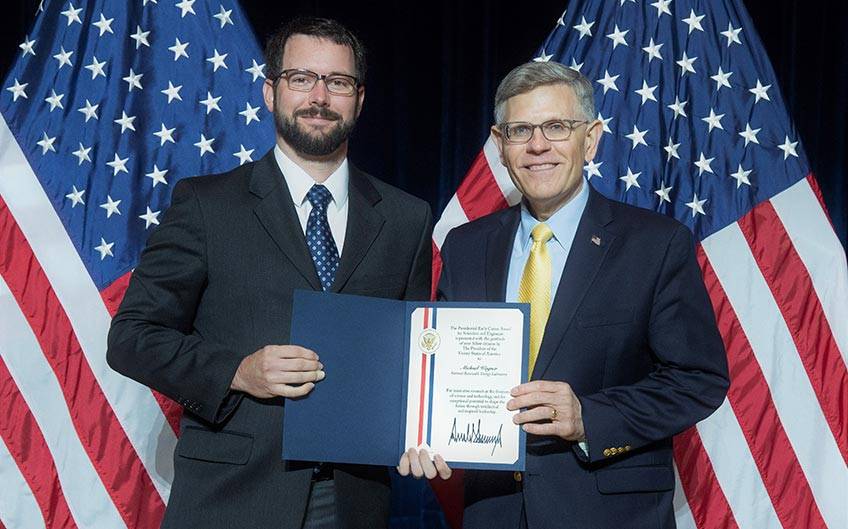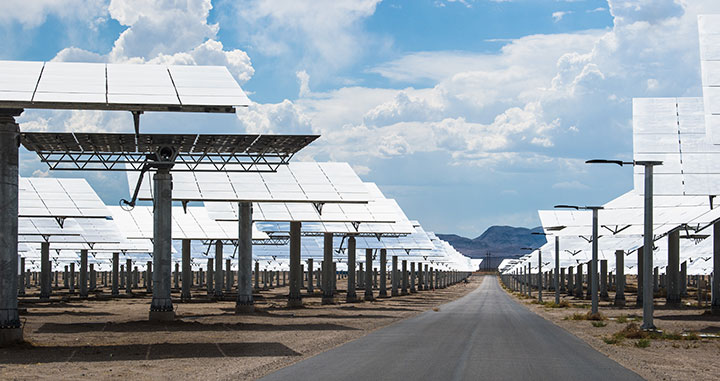Presidential Early Career Award Honors NREL Researcher Mike Wagner
A Leader in Concentrating Solar Power Plant Modeling and Systems Optimization Research Talks about Finding the Operational Sweet Spot, Teamwork, and the Next Renewable Energy Boom

When National Renewable Energy Laboratory (NREL) researcher Mike Wagner opened a congratulatory email from a subcontractor this summer, the last thing on his mind was winning the Presidential Early Career Professional Award for Scientists and Engineers (PECASE). It's the highest honor bestowed by the United States government to outstanding scientists and engineers showing exceptional promise for leadership in their early independent research careers.
The friendly email had even greater significance: it marked the first time the prestigious honor has ever been given to an NREL researcher, and Wagner wasn’t alone—solar photovoltaics scientist Timothy Silverman had also won the PECASE for a separate body of work at the laboratory.
Wagner had been nominated for the award by the U.S. Department of Energy (DOE) Solar Energy Technologies Office in recognition of 10 years of leadership in concentrating solar power (CSP) research. CSP systems capture sunlight to produce or store heat that drives traditional and advanced thermal-based generation systems.
The field continues to interest him because it’s surprisingly complex: “In a way, [CSP] is a very simple technology,” he says, “but there’s a lot to it—optics, thermodynamics, heat transfer, and now, operations and decisions science. It’s a gold mine of research opportunities; there’s so much to do.”
Although there is plenty to do, Wagner has already done a lot to advance the industry. His research at NREL to optimize CSP systems and operations is shaping the technology’s promise for the future energy economy in a number of ways.
Optimizing Concentrating Solar Power Operations (Or, Don’t Slam the Brakes!)
CSP systems offer thermal storage, providing energy that is dispatchable at any time of day—a valuable feature in light of the increasing proportion of variable energy sources such as wind and solar photovoltaics. Questions remain about the appropriate tradeoffs between firing up CSP systems to provide grid services, and long-term wear and tear on the equipment that will impact plants’ future revenue.
To explain, Wagner uses a car analogy. If you’re constantly putting the pedal to the metal when the light turns green, or slamming on the brakes when you reach a stop sign, you’re not going to get as many miles out of your car. “CSP is the same way,” he says. “If you’re starting and stopping the steam turbine all the time, it degrades quickly. You might want to operate it in a way that’s more conservative … but then you’re missing out on the opportunities to sell [energy]. There’s a sweet spot between how aggressively you operate the equipment to take advantage of opportunities for maximizing revenue, while also taking into consideration the longevity of your equipment.”
To help find that operational sweet spot, Wagner has led a series of software development projects taking mathematical models and applying them within detailed engineering software to better estimate the optimal performance of CSP systems. His work includes developing several of the CSP performance models for NREL’s System Advisor Model, which is widely used open-source modeling software for selecting and sizing renewable energy systems. He has also developed NREL’s Solar Power Tower Integrated Layout and Optimization Tool (SolarPILOT), used for modeling optics and optimizing designs.
Second-to-Second Modeling for Real Plants

Building on the software research, Wagner’s team is now working to apply calculations to improve real-time CSP plant operations. Wagner says his goal is to bring the software “to a point where it provides solutions on a second-to-second or minute-to-minute basis in a real plant, where operators use it.”
To this end, the CSP team has been working with operators of the Crescent Dunes plant in northern Nevada, and BrightSource Energy, a developer involved in the Ashalim Solar Thermal Power Station in Israel’s Negev desert, to test the software and improve operational decisions to make the plant performance more predictable and profitable.
How to Get Concentrating Solar Power to “Boom”
Asked about the future direction of CSP research, Wagner began with the caveat that “if I looked back from 10 years ago and was asked where my research would be today, I’d have had no idea.”
Strong-armed to look into his crystal ball, he sees a few possibilities: Intermittent renewables such as wind and solar photovoltaics will continue to dominate renewables deployment. As such, “grid reliability is going to be an important issue. Markets will demand more flexible generation, and then we’ll see a boom of some kind of flexible technology.”
That technology could be battery storage, grid storage, CSP, or something else. He sees a goal of current CSP research as bringing the technology to a level of cost-effectiveness that will enable it to fill that niche for the market when the time comes. Whether the CSP industry is successful will depend on “how well we actually operate these technologies to meet the real needs of the grid.”
To position CSP as a commercially viable technology that can provide this flexible generation, Wagner notes, “There’s a lot of research going into not only the science of operating these plants, but how you build them in the first place to be more responsive. Do you size the storage tank for 10 or 12 hours of storage, for example?” He describes future research directions that include “bottom-line design optimization considerations that have to take into account operations.”
Longer term, Wagner also points to third-generation CSP research, which includes concepts such as higher-temperature operations and the use of carbon dioxide cycles, which are more efficient than traditional steam turbines and lead to lower electricity costs. “If one of those [research pathways] is successful, that might open up new avenues to prove there’s a commercialization path.”
A Huge Honor, and a Group Effort
With regard to the PECASE award, Wagner credits “not only the thermal sciences team—it's been amazing working with them—but NREL deserves a lot of credit because they're the kind of organization with the reputation that gets us this work to begin with.” He specifically calls out the contributions of team members Janna Martinek, Ty Neises, Mark Mehos, and Alex Zolan, as well as Northwestern University, Colorado School of Mines, and Argonne National Laboratory as important partners. “I'm just the lucky one to be able to get up there, and it's a huge honor, but a little unfair to be singled out—it’s a group effort.”
With the whole team, research partners, and NREL in mind, Wagner received the award in July in Washington, D.C. A favorite memory of the day took place during the afternoon award ceremony at the DOE. Wagner’s six-year-old son was in attendance, and a speaker told children in the audience that while they might not know it yet, they should be proud of their parents. Wagner laughs as he remembers “choking up while the higher-ups at DOE spoke to my son.”
NREL Thermal Sciences Group Manager and longtime research collaborator Mark Mehos says Wagner’s PECASE is befitting. “During the past 10 years, I’ve seen how Mike has contributed significantly to our research at NREL and more broadly to the U.S. and international research communities. PECASE is well-deserved recognition for his work advancing the concentrating solar power industry and fulfilling the technology’s promise of delivering flexible and dispatchable generation. We appreciate that DOE thinks so highly of his contributions and nominated him for this recognition.”
Learn more about Michael Wagner’s work and other NREL CSP research at www.nrel.gov/csp/.
Last Updated May 28, 2025
